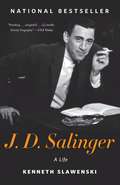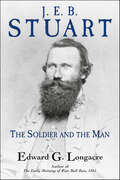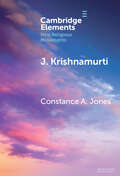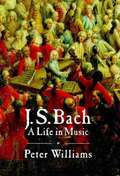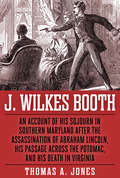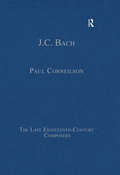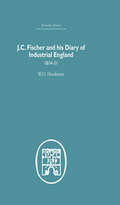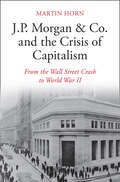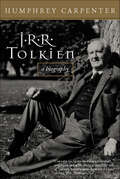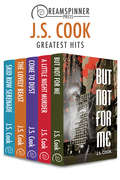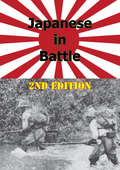- Table View
- List View
J. D. Salinger: A Life
by Kenneth SlawenskiOne of the most popular and mysterious figures in American literary history, author of the classic Catcher in the Rye, J. D. Salinger eluded fans and journalists for most of his life. Now comes a new biography that Peter Ackroyd in The Times of London calls "energetic and magnificently researched"--a book from which "a true picture of Salinger emerges." Filled with new information and revelations--garnered from countless interviews, letters, and public records--J. D. Salinger presents an extraordinary life that spanned nearly the entire twentieth century. Kenneth Slawenski explores Salinger's privileged youth, long obscured by misrepresentation and rumor, revealing the brilliant, sarcastic, vulnerable son of a disapproving father and doting mother and his entrance into a social world where Gloria Vanderbilt dismissively referred to him as "a Jewish boy from New York." Here too are accounts of Salinger's first broken heart--Eugene O'Neill's daughter, Oona, left him for the much older Charlie Chaplin--and the devastating World War II service ("a living hell") of which he never spoke and which haunted him forever.J. D. Salinger features all the dazzle of this author's early writing successes, his dramatic encounters with luminaries from Ernest Hemingway to Laurence Olivier to Elia Kazan, his surprising office intrigues with famous New Yorker editors and writers, and the stunning triumph of The Catcher in the Rye, which would both make him world-famous and hasten his retreat into the hills of New Hampshire.Whether it's revealing the facts of his hasty, short-lived first marriage or his lifelong commitment to Eastern religion, which would dictate his attitudes toward sex, nutrition, solitude, and creativity, J. D. Salinger is this unique author's unforgettable story in full--one that no lover of literature can afford to miss. From the Hardcover edition.
J. E. B. Stuart: The Soldier and the Man
by Edward G. LongacreEdward Longacre provides a balanced portrait of the Civil War's famed cavalryman, J. E. B. Stuart, debunking myths to reveal a complex man known for both his military brilliance and personal flaws. Fifteen years have passed since the publication of the last biography of Jeb Stuart. Several appeared during the last century lauding his contributions to Confederate fortunes in the Eastern Theater. Each follows a familiar tradition established by hero-worshipping subordinates portraying its subject as a model of chivalric conduct with a romantic’s outlook on life and a sense of fair dealing and goodwill, even toward his enemy. J. E. B. Stuart: The Soldier and the Man, by award-winning author Edward Longacre, is the first balanced, detailed, and thoroughly scrutinized study of the life and service of the Civil War’s most famous cavalryman. Long known to scholars and history buffs alike as “The Beau Sabreur of the Confederacy,” James Ewell Brown Stuart of Virginia was possessed of many gifts, personally and professionally, and led the Army of Northern Virginia’s cavalry to the all-but-complete satisfaction of his superiors. Stuart, insisted Robert E. Lee, “never brought me a piece of false information.” Being human, Stuart also under-performed. On occasion, he underestimated his opponents, took unnecessary risks with his habitually understrength command, failed to properly discipline and motivate his troopers, and was prone to errors both strategic and tactical. These flaws were evident during the Gettysburg Campaign, when his wayward route to the battlefield deprived Lee of the ability to safely negotiate his path toward a climactic confrontation with the Union Army of the Potomac. Because of his outsized wartime reputation—one embellished in the century-and-a-half since—most of Stuart’s errors have passed virtually unnoticed or, when addressed, have been excused or explained away in some fashion. Longacre’s study is based on hundreds of published works, archival sources, and newspapers. He probes not only Stuart’s military career but elements of his character and personality that invite investigation. Even the man’s fiercest partisans admitted that he was vain and inordinately sensitive to criticism, with a curious streak of immaturity—at times the hard-edged veteran, at other times a devotee of the pageantry of war, given to affectations such as ostrich-plumed hats, golden spurs, and the headquarters musicians who accompanied him on the march. Ever motivated by appeals to vanity, he curried the patronage of powerful men and responded readily to the attentions of attractive women even though by 1861, he was a long-married man. Personal flaws and limitations aside, Stuart was popular with his officers and men, beloved by members of his staff, and considered by the people of his state and region the beau ideal of Confederate soldiery. The distinction endures today. Longacre’s J. E. B. Stuart is an attempt to determine its validity.
J. Edgar Hoover Goes to the Movies: The FBI and the Origins of Hollywood's Cold War
by John SbardellatiBetween 1942 and 1958, J. Edgar Hoover's Federal Bureau of Investigation conducted a sweeping and sustained investigation of the motion picture industry to expose Hollywood's alleged subversion of "the American Way" through its depiction of social problems, class differences, and alternative political ideologies. FBI informants (their names still redacted today) reported to Hoover's G-men on screenplays and screenings of such films as Frank Capra's It's a Wonderful Life (1946), noting that "this picture deliberately maligned the upper class attempting to show that people who had money were mean and despicable characters." The FBI's anxiety over this film was not unique; it extended to a wide range of popular and critical successes, including The Grapes of Wrath (1940), The Best Years of Our Lives (1946), Crossfire (1947) and On the Waterfront (1954). In J. Edgar Hoover Goes to the Movies, John Sbardellati provides a new consideration of Hollywood's history and the post-World War II Red Scare. In addition to governmental intrusion into the creative process, he details the efforts of left-wing filmmakers to use the medium to bring social problems to light and the campaigns of their colleagues on the political right, through such organizations as the Motion Picture Alliance for the Preservation of American Ideals, to prevent dissemination of "un-American" ideas and beliefs. Sbardellati argues that the attack on Hollywood drew its motivation from a sincerely held fear that film content endangered national security by fostering a culture that would be at best apathetic to the Cold War struggle, or, at its worst, conducive to communism at home. Those who took part in Hollywood's Cold War struggle, whether on the left or right, shared one common trait: a belief that the movies could serve as engines for social change. This strongly held assumption explains why the stakes were so high and, ultimately, why Hollywood became one of the most important ideological battlegrounds of the Cold War.
J. F. K.: Join the Fauci's Killer
by Pier-Giorgio TomatisLe lieutenant de police de Chicago, Jonathan Perry, a mis la pandémie de Covid dans le collimateur de ses enquêtes. Pour découvrir les coupables il sera contraint de quitter les Etats-Unis pour se rendre en Chine, en Russie... et au Nigeria.
J. F. K.: Join the Fauci's Killer
by Pier-Giorgio TomatisDer Chicagoer Polizeileutnant Jonathan Perry hat die Covid-Pandemie ins Fadenkreuz seiner Ermittlungen gerückt. Um die Schuldigen zu finden, wird er gezwungen sein, die Vereinigten Staaten zu verlassen, um nach China, Russland ... und Nigeria zu gehen.
J. F. K.: Join the Fauci's Killer
by Pier-Giorgio TomatisEl teniente de policía de Chicago, Jonathan Perry, ha puesto la pandemia de Covid en el punto de mira de sus investigaciones. Para descubrir a los culpables se verá obligado a abandonar Estados Unidos para ir a China, Rusia... y Nigeria.
J. F. K.: Join to Fauci's Killer
by Pier-Giorgio TomatisChicago Police Lieutenant Jonathan Perry has put the Covid Pandemic in the crosshairs of his investigations. To discover the culprits he will be forced to leave the United States to go to China, Russia ... and Nigeria.
J. Krishnamurti: Self-Inquiry, Awakening, and Transformation (Elements in New Religious Movements)
by Constance A. JonesThis Element explores the life, teaching, and legacy of philosopher and spiritual teacher Jiddu Krishnamurti. From an obscure childhood in south India, he was 'discovered' at age fourteen by the Theosophical Society as the vehicle for the prophesied World Teacher of this cosmic age. At age 34, he disaffiliated from the Society, became an independent teacher, and, for sixty years, traveled widely and addressed thousands of audiences on the need to develop awareness and attention for transformation of consciousness. His teaching defines the human condition as perilous, dominated almost completely by cultural and personal conditioning, fear, and negative emotions. Freedom from these perils, his teaching states, occurs through rigorous self-observation and inquiry in the search for truth. While extremely popular, Krishnamurti rejected the mantle of authority invariably attributed to spiritual masters and teachers. He created schools in his name to implement his pedagogy of non-authoritarianism and freedom from conditioning.
J. S. Bach and the Oratorio Tradition: Bach Perspectives, Volume 8
by Daniel R. MelamedAs the official publication of the American Bach Society, Bach Perspectives has pioneered new areas of research in the life, times, and music of Bach since its first appearance in 1995. Volume 8 of Bach Perspectives emphasizes the place of Bach's oratorios in their repertorial context. These essays consider Bach's oratorios from a variety of perspectives: in relation to models, antecedents, and contemporary trends; from the point of view of musical and textual types; and from analytical vantage points including links with instrumental music and theology. Christoph Wolff suggests the possibility that Bach's three festive works for Christmas, Easter, and Ascension Day form a coherent group linked by liturgy, chronology, and genre. Daniel R. Melamed considers the many ways in which Bach's passion music was influenced by the famous poetic passion of Barthold Heinrich Brockes. Markus Rathey examines the construction and role of oratorio movements that combine chorales and poetic texts (chorale tropes). Kerala Snyder shows the connections between Bach's Christmas Oratorio and one of its models, Buxtehude's Abendmusiken spread over many evenings. Laurence Dreyfus argues that Bach thought instrumentally in the composition of his passions at the expense of certain aspects of the text. And Eric Chafe demonstrates the contemporary theological background of Bach's Ascension Oratorio and its musical realization
J. S. Bach: A Life In Music
by Peter WilliamsA fresh approach to the life and music of Johann Sebastian Bach.
J. Wilkes Booth: An Account Of His Sojourn In Southern Maryland After The Assassination Of Abraham Lincoln, His Passage Across The Potomac, And His De
by Thomas JonesJ. Wilkes Booth: An Account of His Sojourn..., first published in 1893, is the straight-forward account of the doomed escape of John Wilkes Booth following his assassination of Abraham Lincoln. The book was written by Thomas Jones, a Confederate agent who helped Booth evade the authorities for five days by hiding the assassin near his house in Maryland. Illustrated with 18 pen and ink illustrations.
J.B. Priestley: Routledge Modern And Contemporary Dramatists (Routledge Modern and Contemporary Dramatists)
by Maggie B. GaleJ. B. Priestley is the first book to provide a detailed and up to date analysis of the enormous contribution made by this playwright, novelist, journalist and critic to twentieth century British theatre. Priestley was often criticised for being either too populist or too experimental and this study unpicks the contradictions of a playwright and theatre theorist popular with audiences but too often dismissed by critics; describing and analysing in detail not only his plays but also their specific historical and contemporary productions. Using a combination of archive, review and critical materials, the book re-locates Priestley as a theatre theorist of substance as well as a playwright who challenged theatre conventions and assumptions about audience expectations, at a time when theatre was considered both conservative and lacking in innovation.
J.C. Bach
by Paul CorneilsonThis volume of essays brings together the best of recent scholarship on Johann Christian Bach, the youngest son of J.S. Bach and a friend and mentor of Mozart. J.C. Bach had a cosmopolitan career, beginning in Berlin as a pupil of his half-brother, C.P.E. Bach, then a sojourn to Italy where he studied with Padre Martini in Bologna; after making his successful debut with operas for Turin and Naples he moved to London, where he became a leading composer and impresario. The articles selected for this volume represent the principal themes of scholarly research and writing over the past fifty years. The introduction provides a survey of J.C. Bach‘s career and an overview of recent literature. The collection includes English translations of two articles first published in German in the Bach-Jahrbuch, as well as one article published as recently as 2015. An appendix lists the complete contents of The Collected Works of Johann Christian Bach, using the Warburton catalogue numbers.
J.C. Fischer and his Diary of Industrial England: 1814-51
by W.O. HendersonThis book was first published in 1966. It was surprising that so small and so remote a country as Switzerland should have played such an important part in the industrial revolution on the Continent in the nineteenth century. A lack of natural resources and basic raw materials and population of 1,687,000 in 1817, faraway trade ports, and until 1848 no real central government with the administrative structure to support expansion of manufacturers. However, the people were hardworking, thrifty and high standards of workmanship; and had good relations with France and Germany, which saw the watchmakers, silkweavers and chocolate crafters start to thrive. Johann Conrad Fischer was typical of the entrepreneurs who laid the foundations of Switzerland's prosperity with his steelworks.
J.M. Keynes Versus F.H. Knight: Risk, Probability, and Uncertainty (Evolutionary Economics and Social Complexity Science #18)
by Yasuhiro SakaiThis book critically discusses and systematically compares J.M. Keynes and F. H. Knight, two giants in the history of economic thought. In 1921 they both published apparently similar books on risk, probability, and uncertainty. However, while Knight's contribution on risk and uncertainty is now well recognized, Keynes's work on probability and uncertainty has been somewhat ignored in the shadow of his more famous The General Theory of Employment, Interest and Money (1936). Focusing on an earlier yet equally important volume by Keynes, A Treatise on Probability (1921), this book sheds a light on his outstanding ideas and the lasting influence on his later works, including The General Theory. There are few books that systematically discuss Keynes and Knight, although there are remarkable comparisons between Keynes's concept of probability and uncertainty and Knight's distinction between a measurable risk and a non-measurable uncertainty. This timely book unifies Keynes and Knight into a new, comprehensive approach to a very complex human behavior
J.P. Morgan & Co. and the Crisis of Capitalism: From the Wall Street Crash to World War II
by Martin HornDuring the interwar period, J.P. Morgan was the most important bank in the world and at the crossroads of US politics, international relations and finance. In J.P. Morgan & Co. and the Crisis of Capitalism, Martin Horn brings us the first in-depth history of how J.P. Morgan responded to the greatest crisis in the history of financial capitalism, shedding new light on the Great Depression, the New Deal, and the coming of World War II. Horn shows how J.P. Morgan & Co as a business responded to the 1929 Crash and the Depression, including its part in the New York Stock Exchange Crash, arguing that the Morgan partners misread the seriousness of the crash. He also offers new insights into the interactions of politics and finance, exploring J.P. Morgan's relationship with the Hoover administration and the bank's clash with Roosevelt over New Deal legislation.
J.R.R. Tolkien: A Biography
by Humphrey CarpenterThe authorized biography of the creator of Middle-earth. “One of the most interesting and readable biographies of a literary figure.” —The TimesIn the decades since his death in September 1973, millions have read The Hobbit, The Lord of the Rings, and The Silmarillion and become fascinated about the very private man behind the books. Born in South Africa in January 1892, John Ronald Reuel Tolkien was orphaned in childhood and brought up in near-poverty. He served in the first World War, surviving the Battle of the Somme, where he lost many of the closest friends he’d ever had. After the war he returned to the academic life, achieving high repute as a scholar and university teacher, eventually becoming Merton Professor of English at Oxford where he was a close friend of C. S. Lewis and the other writers known as “The Inklings.”Then suddenly his life changed dramatically. One day while grading essay papers he found himself writing “In a hole in the ground there lived a hobbit”—and worldwide renown awaited him.Humphrey Carpenter was given unrestricted access to all Tolkien’s papers, and interviewed his friends and family. From these sources he follows the long and painful process of creation that produced The Lord of the Rings and The Silmarillion and offers a wealth of information about the life and work of the twentieth century’s most cherished author.“J. R. R. Tolkien left his impress upon a whole generation as few recent writers have done . . . an excellent biography.” —Newsweek“A panorama of vignettes done with poise and exhaustive command. A man emerges whole.” —The Washington Post Book World
J.S. Cook's Greatest Hits (Dreamspinner Press Bundles #20)
by J. S. CookEnjoy J.S. Cook's best mysteries, with a side of lust and romance, in this collection. In But Not for Me, gangster boss Nino Moretti rescues beautiful mob accountant Stanley Zadwadzki from a rival, but the consequences may cost them any chance at a relationship. In A Little Night Murder, insurance investigator Frank Boyle may have escaped from danger once with help from detective Sam Lipinski, but a new investigation is turning up trouble once again. In Come to Dust, Inspector Philemon Raft is set adrift among the deceitful ton of turn-of-the-century London, trying to locate the kidnapped Miriam Dewberry. In The Lovely Beast, Jacob van Willingen is on a mission to exterminate the evil Caleb Donnithorn, but things aren't quite what they seem to be at this Romanian castle. In Skid Row Serenade, novelist and war hero Tony Leonard visits his estranged wife only to find her beaten to death. On the run, he decides to fake his own death, with a little help from private investigator Edwin Malloy.See excerpt for individual blurbs.But Not for Me previously published by Dreamspinner Press, March 2013Cover Art by Aaron Anderson aaronbydesign55@gmail.comA Little Night Murder previously published by Dreamspinner Press, September 2013Cover Art by Catt FordCome to Dust previously published by Dreamspinner Press, November 2013Cover Art by Maria FanningThe Lovely Beast previously published by Dreamspinner Press, July 2014Cover Art by L.C. Chase http://www.lcchase.comSkid Row Serenade previously published by Dreamspinner Press, August 2015Cover Art by Aaron Anderson aaronbydesign55@gmail.com
J.S. Mill (Routledge Revivals)
by Alan RyanFirst published in 1974. As logician, economist, political theorist, practical politician and active champion of social freedom, John Stuart Mill is a figure of continuing importance. In this book the author does full justice to the range of Mill’s achievements, providing an introductory guide to his most important and best known writings including Autobiography, A System of Logic, Utilitarianism, Liberty, and The Subjugation of Women. In their treatment of his works, the author seeks to emphasise Mill’s approach to those issues — education, the conflict between social order and individual freedom, the unresolved state of the social sciences, rights and duties of citizens in a democratic state — which remain most alive to us today. At the same time Mill is seen as part of his own age, responding to the anxieties that beset his contemporaries. This book will be of interest to students of politics and philosophy.
J.W. McConnell: Financier, Philanthropist, Patriot
by William FongJ.W. McConnell (1877-1963), born to a poor farming family in Ontario, became one of the wealthiest and most powerful businessmen of his generation - in Canada and internationally. Early in his career McConnell established the Montreal office of the Standard Chemical Company and began selling bonds and shares in both North America and Europe, establishing relationships that would lead to his enormous financial success. He was involved in numerous businesses, from tramways to ladies' fashion to mining, and served on the boards of several corporations. For nearly fifty years he was president of St Laurence Sugar and late in life he became the owner and publisher of the Montreal Star. McConnell was an indefatigable and formidable fundraiser for the YMCA, the war effort of 1914/18, hospitals, and McGill University, where he served as governor for almost three decades. In 1937 he established what would become The J.W. McConnell Family Foundation, the first major foundation in Canada and still one of the best endowed. J.W. McConnell was a principled and brilliant visionary with a strong work ethic and a deep commitment to the public good, a Rockefellerian figure in both big business and high society who quietly became one of the greatest philanthropists of his time. His life story - told in uncompromising detail by William Fong - is a study of raising, spending, and giving away money on the grandest scale.
JAMerica: The History of the Jam Band and Festival Scene
by Peter ConnersThe term "jam band" is used to categorize a type of music that favors improvisation and musicianship over concise riffs, hooks, and traditional songwriting structure. The term also helps define the fiercely dedicated fans of the music as accurately as it does the bands. Much as with the Grateful Dead-the progenitors of the jam band scene-the survival of the scene depends upon a symbiotic relationship with fans. Jam bands nurture a close relationship with their fans, fostered through constant touring and the mutual belief that each performance is a unique, shared event.JAMerica tells the story of the roots, evolution, values, and passion of the jam band scene in the words of those who know it best. Modeling itself on such books as Edie: American Girl by George Plimpton and Jean Stein (an oral history of the life of Edie Sedgewick ) and Please Kill Me: The Uncensored Oral History of Punk by Legs McNeil and Gillian McCain, the book is an oral history of the jam band scene, integrating stories from such bands as the Grateful Dead, Phish, Widespread Panic, Dave Matthews Band, moe., Leftover Salmon, String Cheese Incident, Umphrey's McGee, and dozens more. Interviews focus on the history of individual bands and how they communally shaped the larger jam band community, along with songwriting, relationships with fans, business models, and the importance (including the joys and war stories) of touring, including early gigs and venues (e.g. the Wetlands in New York City and the landmark H.O.R.D.E. Festival) that supported the emergence of the jam band scene.
JAPANESE IN BATTLE 1st Edition [Illustrated Edition] (JAPANESE IN BATTLE #1)
by Military Intelligence Staff GHQ IndiaIllustrated with more than 20 maps plans and photos.When this handbook was written in 1943 the Japanese soldier was seen by British Empire troops as a jungle fighting superman, who had largely blitzed and defeated them at every turn. As part of an effort to dispel this myth the Intelligence Section of General Headquarters in India set about distilling the tactics that the Japanese had used and to formulate counter-measures. As the staff point out in their introduction;"The Japanese are an island race who have mastered the art of war, not through any mysterious or indefinable quality inherited from their Emperor, their islands, or their ancestors during your grandfather's time they were still in the bow-and-arrow stage-but through serious study of ancient and modern methods, and by intensive training. If we analyse their tactics, reducing them to fundamentals, all that they practise is to be found in our own training manuals, or in the military histories of ancient campaigns; not even the snipers in the trees are new-the jungle tribes of Africa and Brazil have employed them since time immemorial."In their long history the peoples of our Empire have shown the world that they possess more than an average share of courage and tenacity, and today we must add to these advantages our undoubted superiority in arms and equipment. Any success which the Japanese have had against us was due to intensive training, carefully rehearsed plans and normal guts. Whatever the task in hand-be it the digging of a single fox-hole or the preparation of a large-scale invasion-their work is done with meticulous care, and by intensive and sustained training alone can we hope to outmanoeuvre them."As close to a handbook in English of how the Japanese fought and won their battles in the jungles of Southeast Asia at the beginning of the Second World War: A fascinating read.
JAPANESE IN BATTLE 2nd Edition [Illustrated Edition] (JAPANESE IN BATTLE #2)
by Military Intelligence Staff GHQ IndiaIllustrated with more than 30 maps plans and photos.Written in August 1944 when the Japanese Imperial armies had tasted their first bitter defeats in Burma; the staff of GHQ India were determined to record all of the lessons learned and ensure that the troops in the field would profit from the knowledge. A brilliant exposition of the Japanese methods of land warfare in the later stages of the Second World War as can be found.Although titled as a second edition, this World War Two briefing book is in fact almost completely different from the first Edition.
JB Chifley: An Ardent Internationalist
by Julie SuaresThis, combined with his rural background and commitment to the labour movement, played a major role in the development of his internationalist perspective. Often overlooked by historians, Chifley believed that the only way to avoid war and economic depression was through the establishment of international rules-based economic and collective security institutions. These were beliefs he had held since the early 1930s. Chifley was a prime minister with a keen interest in post-war Asia, who understood that the old colonial order was ending. He was a great admirer of the Indian Prime Minister, Jawaharlal Nehru. This book reveals the extraordinary convergence of worldviews of two fellow internationalists, Chifley and Nehru. This convergence can be seen in their views on the need to adjust to a changing post-colonial world; their internationalism; their support for the United Nations; their opposition to Western colonialism; their anti-war attitudes and their animosity towards the American and British Cold War framework through which the post-war world was viewed. Historian Frank Bongiorno wrote about Julie's work on Chifley: ' . . . it is a tremendous achievement to produce such a new vision of a major political figure . . . it is an important contribution to Australian political, foreign policy and intellectual history'.
JELL-O Girls: A Family History
by Allie RowbottomA "gorgeous" (New York Times) memoir that braids the evolution of one of America's most iconic branding campaigns with the stirring tales of the women who lived behind its facade - told by the inheritor of their stories. <P><P>In 1899, Allie Rowbottom's great-great-great-uncle bought the patent to Jell-O from its inventor for $450. The sale would turn out to be one of the most profitable business deals in American history, and the generations that followed enjoyed immense privilege - but they were also haunted by suicides, cancer, alcoholism, and mysterious ailments. More than 100 years after that deal was struck, Allie's mother Mary was diagnosed with the same incurable cancer, a disease that had also claimed her own mother's life. <P><P>Determined to combat what she had come to consider the "Jell-O curse" and her looming mortality, Mary began obsessively researching her family's past, determined to understand the origins of her illness and the impact on her life of Jell-O and the traditional American values the company championed. Before she died in 2015, Mary began to send Allie boxes of her research and notes, in the hope that her daughter might write what she could not. JELL-O GIRLS is the liberation of that story. <P><P>A gripping examination of the dark side of an iconic American product and a moving portrait of the women who lived in the shadow of its fractured fortune, JELL-O GIRLS is a family history, a feminist history, and a story of motherhood, love and loss. In crystalline prose Rowbottom considers the roots of trauma not only in her own family, but in the American psyche as well, ultimately weaving a story that is deeply personal, as well as deeply connected to the collective female experience.
